What is a Pollinator Garden?
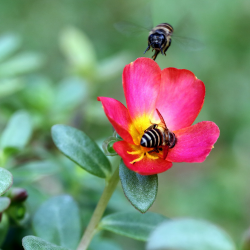 Did you know…
Did you know…
Approximately 200,000 species of pollinators are beneficial insects such as bees, flies, beetles, wasps, and butterflies. Hummingbirds represent a small percentage of natural pollinators. Honey bees and native bees (bumblebees, carpenter bees, sweat bees, mining bees, mason bees, etc.) are critical to our food supply and pollinate about one-third of the foods we enjoy.
Bees as well as other pollinators are also essential components of the habitats and ecosystems that many wild animals rely on for food and shelter. As natural areas are cleared for development, and pesticides are sprayed, pollinator habitat is destroyed or fragmented, resulting in the loss of foraging and nesting sites. This can lead to a decline in pollinator population.
One big way we can help pollinators is by planting forage habitat that provides nectar and pollen. Our main goal is to have plants that flower throughout the growing season, from early spring-late fall, with periods of overlapping bloom periods.
Pollinator Protective Pledge
for Southport’s Native Plant Habitat
- Grow a variety of bee-friendly flowers that bloom from spring through fall.
- Protect and provide bee nests and caterpillar host plants.
- Avoid using pesticides, especially insecticides.
- Talk to our neighbors about the importance of pollinators and their habitat.
The Southport Pollinator Garden is
registered as a Monarch Waystation!

Congratulations to the City of Southport on officially becoming Bee City USA on April 20, 2022
Bees are central to our lives
Thousands of native species sustain our environment and food supply
Bee City USA & Bee Campus USA bring people together to make their communities better places for pollinators
- Being an affiliate ensures the survival of vital animal species
- Builds community locally and nationally around a positive shared cause, along with the ability to connect with communities across the country that have made the same commitment
- Improves local food production
- Supports local communities and small businesses by creating awareness of pollinator-friendly landscaping
- Address pest issues with fewer pesticides by raising community awareness of the least toxic ways to tackle home & garden pest problems
- Build Community Awareness on the importance of using native plants instead of non-native invasive plants
- Heighten awareness of biological diversity of plant & pollinator species
Questions?
For more information or to lend a helping hand, [email protected]
Focus on Fennel

Fennel (Foeniculum vulgare), is well known as a hearty perennial herb. It is also in the carrot family. If you were to taste fennel, it would taste like licorice/anise flavor.
It has feathery leaves, and later in the season will produce yellow flowers.
 In the Southport native plant pollinator garden right now, the green fennel and bronze fennel are full of feathery leaves. Something magical is happening now – if you look closely, you may see a caterpillar or two, munching away on those feathery leaves. The fennel is a host plant for the Black Swallowtail larva/caterpillar, which will then become the butterfly.
In the Southport native plant pollinator garden right now, the green fennel and bronze fennel are full of feathery leaves. Something magical is happening now – if you look closely, you may see a caterpillar or two, munching away on those feathery leaves. The fennel is a host plant for the Black Swallowtail larva/caterpillar, which will then become the butterfly.

The Magic of Milkweed and Monarchs
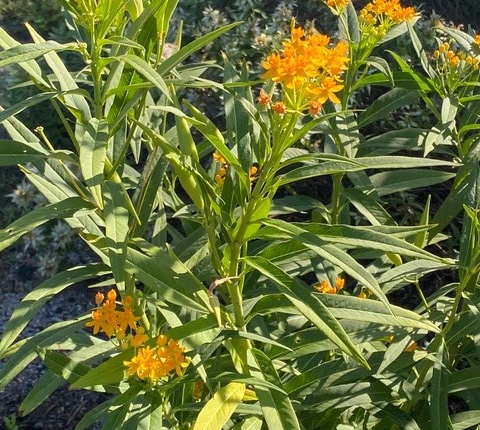 Planting milkweed contributes to monarch butterfly conservation. In our native plant pollinator garden at Lowe-White Park, we have several butterfly milkweed – (Asclepias tuberosa), of various sizes, with orange and or yellow blooms. These blooms last well into early fall. Each fall the monarch butterflies migrate to the mountains in central Mexico. They return to the US and Canada in the spring, to start new generations of monarchs.
Planting milkweed contributes to monarch butterfly conservation. In our native plant pollinator garden at Lowe-White Park, we have several butterfly milkweed – (Asclepias tuberosa), of various sizes, with orange and or yellow blooms. These blooms last well into early fall. Each fall the monarch butterflies migrate to the mountains in central Mexico. They return to the US and Canada in the spring, to start new generations of monarchs.
Monarch caterpillars need milkweed plants to grow and develop. The female monarch butterfly will only lay her eggs on the milkweed. Many flowering plants will attract adult monarchs, but milkweed is the only host plant for monarchs, which will produce successive generations of monarch butterflies. Once the monarch butterfly is hatched, it only lives for about 2-6 weeks, although the last generation of the year can live up to 8 or 9 months.
“Plant milkweed and they will come”
Milkweed plants that are native to the Southeast region of the US: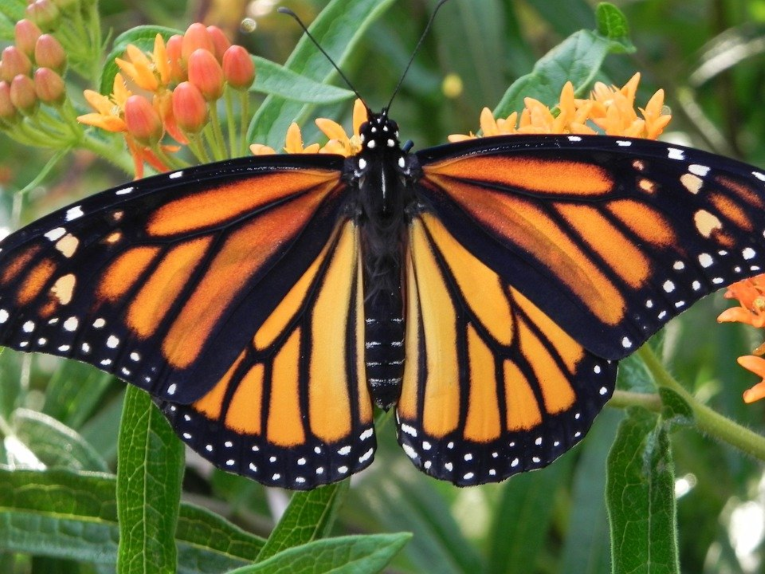
- Aquatic Milkweed – Asclepias perennis
- White Milkweed – Asclepias variegate
- Butterfly Milkweed – Asclepias tuberosa
Take a walk in the pollinator garden and see how many milkweed plants you can find before our blooms disappear. Also look for some of the seedpods as the blooms disappear.
www.MonarchWatch.org – for more information.
The Gulf Fritillary Meets the Passion Vine and Flower
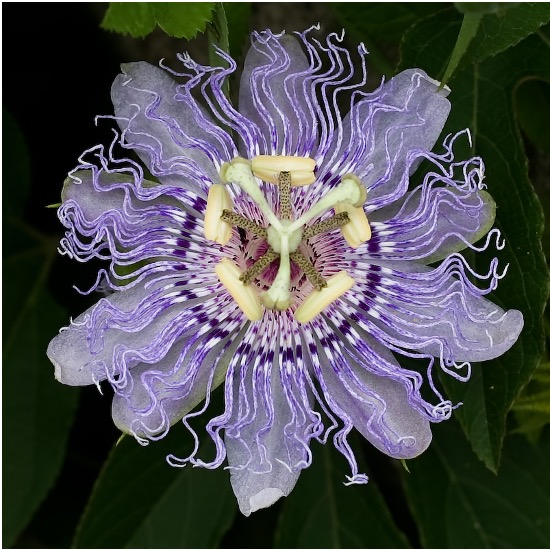
The host plant for the fritillary butterfly is from the genus Passiflora or Passion vine/flower.
The adult Gulf Fritillary is a medium-sized butterfly with elongated forewings. Adults have a wingspan range of 65 to 95 mm. Females are generally larger than males. The upper surface of the wings is bright orange with black markings. Females are somewhat darker and more extensively marked. The forewing cell contains three black-rimmed white spots. The undersides of the wings are brown with elongated silvery-white spots.
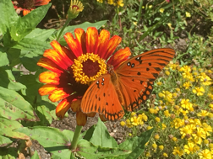
Gulf Fritillaries have several broods in the spring and summer, and reach peak populations from August through November in the South.
The mature larvae have a bright orange tone with innumerable black branched spines all over their glossy body, but they do not sting. The average duration of this stage is between 11 and 16 days. As a defensive mechanism, the larva is poisonous. Their toxic flesh provides them with excellent protection against predators. (Photo courtesy of SPT pollinator garden)
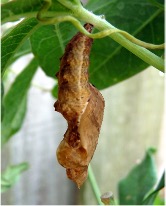 The chrysalis is light to mottled brown with faint gray marking all over the body. Their coloration is an adaptation that helps them to camouflage easily amongst the branches of trees. This is a cocoon stage usually lasts for 7 to 12 days.
The chrysalis is light to mottled brown with faint gray marking all over the body. Their coloration is an adaptation that helps them to camouflage easily amongst the branches of trees. This is a cocoon stage usually lasts for 7 to 12 days.
Butterfly Eggs Small, spherical and yellow, laid individually on or plant leaves near the host.

Sources: jaxshell.org, butterflyidentification.com, butterfliesathome.com
10 Steps to a Better Butterfly Garden
READ. Get a good butterfly identification book, such as Gardening for Butterflies by the Xerces Society and The Life Cycle of Butterflies by Judy Burris and Wayne Richards.
Feed ‘EM. Add nectar-rich annuals, such as zinnias, Mexican sunflower, and lantana, which bloom from spring through fall.
PLANT IN DRIFTS. Butterflies floating overhead are attracted to groups of flowers.
SELECT SINGLES. Include perennials and annuals that have larger, single daisy type flowers. A butterfly will spend more time and save energy visiting one large blossom to gather nectar.
GO NATIVE. Add some plants that are native to our region. Native plants support thousands of species of pollinators including native bees, butterflies, moths, flies, wasps, and flower-visiting beetles.
GROW HOST PLANTS. Create a butterfly nursery by growing their preferred food plants. For example, Black Swallowtails will lay eggs on dill, fennel, and parsley.
BE A LAZY GARDENER. Hold off on fall cleanup of annuals and perennials until spring. Some butterfly chrysalises (pupas) overwinter in the garden.
BE A BUTTERFLY BARTENDER. Place a shallow dish of wet sand or water where butterflies can sip water. Some species visit wet sites to glean salts and nutrients not found in nectar.
GET INVOLVED AND LEARN. Join the North American Butterfly Association, naba.org.
SKIP THE PESTICIDES. Many products are indiscriminate and will kill all kinds of caterpillars.
Wonder what happens to the pollinators during the winter months…?
As you walk through our native plant pollinator garden in Lowe White Park, when it is chilly outside and really nothing is in bloom, believe it or not there is still a lot happening in the garden. Many of our plants have withered and dropped leaves. This may look like it’s time to clean up in many areas. But approximately 70% of bee species nest in the ground in yards and gardens, as well as butterflies and moth larvae. As an added bonus, beneficial insects such as the ladybeetles find shelter in leaves and mulch piles – they will be ready to attack aphids in the spring!
As our beautification volunteers begin to weed and dig to move a few perennials, we will keep in mind to dig down no more than 6” and keep our eyes open for any of our nesting pollinators who will be back very soon to do their good work in the garden.
Real Estate for the Mason Bee
 Check out the new addition to our Native Plant Pollinator Garden – The Mason Bee House! This lovely little home was made and donated by Beautification Committee member Alderman Tom Lombardi.
Check out the new addition to our Native Plant Pollinator Garden – The Mason Bee House! This lovely little home was made and donated by Beautification Committee member Alderman Tom Lombardi.
Encouraging wild mason bees to our native habitat – could help counter the negative effects of declining honeybee colonies.
Every female is a “queen”. These bees lay their eggs inside existing tunnels, such as those left by wood-boring beetles or the hollow stems of pithy plants, or homemade “houses”. After mating and finding an existing tunnel for her nest, the female bee gathers mud in her large jaws and uses it to build a wall at the back of the tunnel – thus the name “mason bee.” Next, she makes dozens of visits to garden flora to collect pollen and nectar, which she heaps into a golden nugget at the end of the tunnel. This nutritious pollen-nectar mass will be her egg’s first meal when it hatches. Finally, she backs into the tunnel and deposits an egg on top of the food source. Once the egg is laid, the female bee collects more mud and uses it to build a wall that seals off the egg inside its own chamber. She repeats this process until the tunnel is filled with well-provisioned eggs, each tucked inside its own cell partition. Then she closes the tunnel with a mud plug to protect her offspring from predators.
Early spring mason bees emerge from hibernation when temperatures reach about 55 degrees. A mason bee will fill as many nesting tunnels as she can during her roughly 4-week life span – pollinating flowers profusely as she forages for food to supply her nest. Then she dies.
Ecolandscaping.org
Interactive Human Sundial
A new addition to the Pollinator Garden is the Human Sundial. A human sundial uses your own shadow to tell the correct time.
How to tell time:
- Please stand on the current month
- Your shadow, maybe with arms raised, will fall on the current hour block
- During the period of Eastern Standard Time, please subtract one hour
HAVE FUN!



